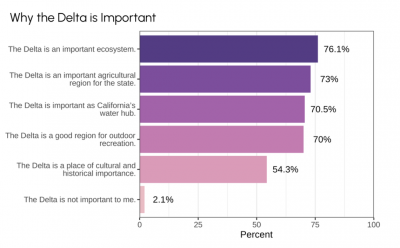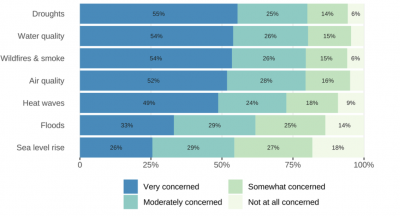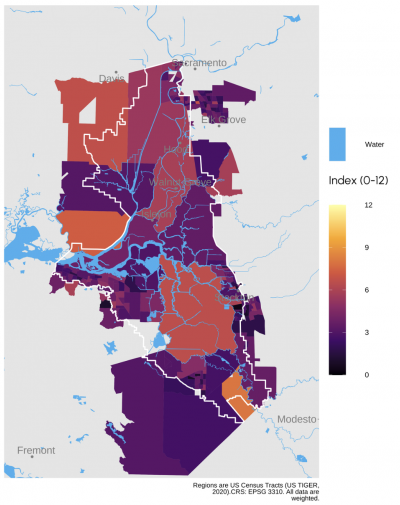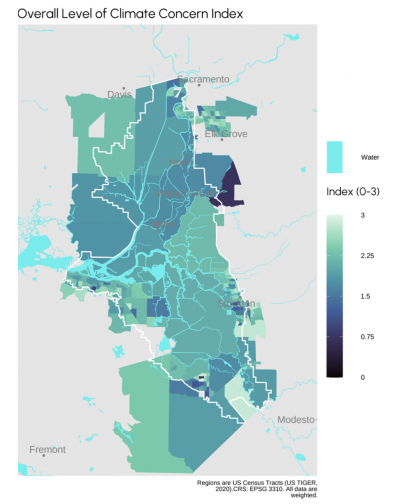The Sacramento-San Joaquin Delta is, in many ways, a place of legend. It's one of the world’s great wetlands, now heavily reworked for agriculture. Two-thirds of Californians depend on the region for drinking water. Millions of birds and fish pass through each migratory season.
But what do locals think of their home? That, for many years, has been a missing piece of data. A recent, first-of-its-kind survey helped sharpen the picture — finding that while diverse residents agree that it’s an important and complex region, their satisfaction with their quality of life varies widely.
The Delta, formed by the confluence of the Sacramento and San Joaquin rivers, spans a half-million acres, including portions of six counties. It’s home to 600,000 people and — though the local waterways have been heavily reworked by levees and canals — hundreds of native plant and animal species.
In 2009, a state law established “coequal goals” for the Delta: safeguarding its health, ecological and social, while ensuring water security for the entire state of California. That led to much scientific scrutiny, notes Jess Rudnick, who helped lead the survey as an extension agent with California Sea Grant. Mostly, though, the science has focused on the ecological implications of these goals.
When a river is altered, biologists check to see how fish respond. “But we don’t monitor how the people respond to the change,” Rudnick says, “or how the economies and the livelihoods of people change.” The Delta Resident Survey is meant as a first step to take the people living in the region into account.
A sense of the Delta

And residents seemed eager to be heard. From February to April 2023, a total of 82,000 households received a mailed invitation to participate in the survey. That included all 6,000 households in the rural core of the Delta, as well as a random sampling of households in what Rudnick calls the Delta’s “urban corners” — cities and suburbs that often are left out of local discussions, even though environmental interventions within the Delta can heavily impact these communities, too. The survey yielded 2,208 usable responses — a higher percentage than surveys usually achieve.
Particularly illuminating for researchers like Rudnick were questions that explored residents’ “sense of place” — their sense of connection to the Delta, and their sense of its importance. The answers revealed that people in the Delta have some shared sense of identity, despite the range of demographics, from race to class. Respondents largely agreed that the Delta is a complex and important place, a keystone for California's agriculture and ecosystems. They appreciated its scenic beauty and value for recreation.

Yet, they are also united in a darker commonality. Across the board, respondents showed little faith in local, state and federal governmental institutions. Scientific experts, in comparison, scored much higher.
Residents also worried that the Delta is vulnerable to climate change. This might seem surprising in a mostly rural region, Rudnick notes, where even residents of the urban corners are intertwined with the agricultural economy. The shifts of the past few years seem hard to deny, though: The survey was conducted after two extraordinarily dry years, followed by one of the wettest winters on record in California.
A diverse place
Despite these shared experiences, “the Delta should not be characterized as a homogenous community legally, environmentally, socially, politically, hydrologically, or economically,” one respondent wrote in the survey. The numerical data confirmed this sentiment.

Urban residents expressed more appreciation for the Delta’s recreational value for activities like boating and hunting. Rural residents, by contrast, cherished its quiet and scenic aspects. They also expressed more concern about specific projects, such as the Delta Conveyance Project, as well as a desire to protect the Delta “way of life.”
Rural residents were also more satisfied with their quality of life. (Partly, this might reflect that many of them are older, white and higher-income — all demographic characteristics that tend to correlate with higher life satisfaction.) Still, overall, life satisfaction in the Delta skews slightly below national averages.
The fact that the survey was able to collect such different voices was itself a win. “We heard from a lot of people who haven’t previously engaged — opinions and perspectives that aren’t the dominant narrative that comes up again and again in public meetings,” Rudnick says.
But there is more work to do to bring all voices to the table. The survey revealed that, beyond voting and signing petitions, Delta residents are not particularly engaged in the political process, rarely reaching out to their elected officials or participating in public meetings. This may be linked to the lack of trust that residents expressed in government agencies.
Continuing the process
Key questions, then, remain, Rudnick notes, How do you reach more people? How do you improve the democratic process and ensure more voices are represented?

“There’s not an easy answer here,” Rudnick says. “The problem is harder than we thought it was initially.” One potential takeaway for state and local agencies: It might be important to reflect on how much they engage the full range of voices within their constituent populations.
The anonymized set of survey responses will be made publicly available on the project website early next year, along with an interactive tool to guide exploration. “A city manager will be able to dive into the data to see how their constituents think about issues like climate change,” Rudnick says.
The research team will also develop fact sheets that highlight key takeaways. But the data might become even more useful in the long term, Rudnik thinks, as future versions of the survey are sent out, hopefully every four or five years. “How are people responding to changes in the Delta? The best way to know is to ask and to keep asking,” Rudnick says.
About California Sea Grant
NOAA’s California Sea Grant College Program funds marine research, education and outreach throughout California. Headquartered at Scripps Institution of Oceanography at the University of California San Diego, California Sea Grant is one of 34 Sea Grant programs in the National Oceanic and Atmospheric Administration (NOAA), U.S. Department of Commerce.